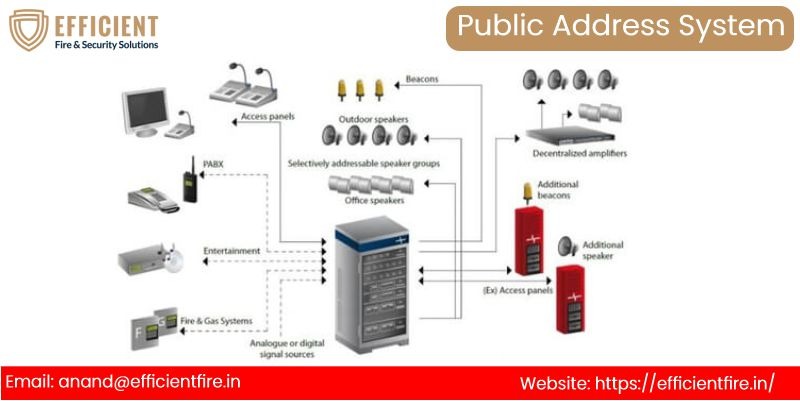

Enhancing Safety and Communication: The Role of Public Address Systems
Public Address system play a crucial role in facilitating communication and ensuring safety in various public and private settings. From emergency announcements to routine information dissemination, Public Address systems serve as indispensable tools for reaching large audiences efficiently. Efficient fire is best Public Address System Manufacturers, Public Address System Supplier Company in Pune, India.
This article explores the significance, components, and applications of public address system in enhancing safety and communication.
Importance of Public Address Systems
Public address system are essential for delivering announcements, alerts, and instructions to people in diverse environments, including:
1 ) Emergency Notifications: Public Address system are used to broadcast emergency alerts, such as fire alarms, severe weather warnings, and evacuation instructions, to ensure timely response and safe evacuation.
2) Information Dissemination: Public Address system provide a means of sharing important information, such as event schedules, public announcements, and operational updates, in settings like airports, train stations, stadiums, and shopping malls.
3) Crowd Management: In large venues and public gatherings, Public Address system help manage crowds by providing directions, guiding traffic flow, and making announcements related to crowd safety and event logistics.
Components of Public Address Systems
1. Microphones: Microphones are used to capture audio input from speakers or operators for live announcements and broadcasts.
2. Amplifiers: CO2 extinguishers are suitable for fires involving electrical equipment and flammable liquids. The discharged CO2 displaces oxygen, suffocating the fire.
3. Loudspeakers: Loudspeakers or speakers are the output devices that broadcast the audio messages to the intended audience.
4. Control Units: Control units include mixers, processors, and switchers that manage audio inputs, control volume levels, and route signals to the appropriate output channels.
5. Emergency Alert System (EAS): Some Public Address system are integrated with emergency alert systems to automatically broadcast pre-recorded emergency messages in response to specific triggers, such as fire alarms or severe weather alerts.
Applications of Public Address Systems
1. Transportation Hubs: Public Address system are installed in airports, train stations, and bus terminals to provide travellers with announcements regarding departures, arrivals, gate changes, and safety instructions.
2. Educational Institutions: Schools, colleges, and universities use Public Address system for making announcements, calling students to assemblies, and broadcasting emergency alerts.
3. Commercial Buildings: Public Address system in office buildings, shopping centres, and hotels are used for public announcements, emergency notifications, and background music.
4. Entertainment Venues: Public Address system in stadiums, concert halls, theatres, and amusement parks deliver announcements, event promotions, and safety instructions to patrons.
Benefits of Public Address Systems
1. Rapid Communication: : Public Address system enable instant communication with large groups of people, facilitating quick dissemination of information and emergency alerts.
2. Enhanced Safety: :By providing timely notifications and instructions during emergencies, Public Address system contribute to public safety and help prevent panic.
3. Operational Efficiency: : Public Address system streamline communication within organizations, improving efficiency in managing crowds, coordinating events, and disseminating information
4. Accessibility: : Public Address system can be equipped with features such as visual displays, text-to-speech capabilities, and multilingual support to ensure accessibility for individuals with hearing impairments or language barriers.
Conclusion
Public address systems are indispensable tools for enhancing safety, communication, and operational efficiency in diverse public and private settings. By leveraging the capabilities of Public Address system and integrating them with modern technology and emergency alert systems, organizations can effectively communicate with their audiences and respond to evolving safety and communication needs.

Leave a comment
All fields marked with an asterisk (*) are required